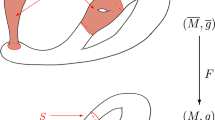Abstract
We present an organized method to convert between partial derivatives of metrics (functions) and covariant derivatives of curvature tensors (functions) on Kähler manifolds. Basically, it reduces the highly recursive computation in tensor calculus to the enumeration of certain trees with external legs.
Similar content being viewed by others
Notes
More precisely, what Engliš and Peetre called the higher Laplace–Beltrami operator is the conjugate operator \(\bar{L}_m f=g^{a_1\bar{b}_1}\cdots g^{a_m\bar{b}_m}f_{/\bar{b}_1\cdots \bar{b}_m a_1\cdots a_m.}\)
References
Engliš, M.: The asymptotics of a Laplace integral on a Kähler manifold. J. Reine Angew. Math. 528, 1–39 (2000)
Engliš, M., Peetre, J.: Covariant Cauchy-Riemann operators and higher Laplacians on Kähler manifolds. J. Reine Angew. Math. 5478, 17–56 (1996)
Fefferman, C.: Parabolic invariant theory in complex analysis. Adv. Math. 31, 131–262 (1979)
Gilkey, P.: Invariance Theory, the Heat Equation and the Atiyah-Singer Index Theorem. Publish or Perish Inc., Lombard (1984)
Gray, A.: The volume of a small geodesic ball of a Riemannian manifold. Michigan Math. J. 20, 329–344 (1973)
Hirachi, K., Komatsu, G.: Invariant theory of the Bergman kernel. In: CR-Geometry and Overdetermined Systems (Osaka, 1994). Advanced Studies in Pure Mathematics, vol. 25, pp. 167–220. Mathematical Society of Japan, Tokyo (1997)
Karabegov, A.: An invariant formula for a star product with separation of variables. J. Geom. Phys. 62, 2133–2139 (2012)
Liu, K.: Heat kernels, symplectic geometry, moduli spaces and finite groups. Surv. Differ. Geom. 5, 527–542 (1999)
Lu, Z.: On the lower order terms of the asymptotic expansion of Tian-Yau-Zelditch. Amer. J. Math. 122(2), 235–273 (2000)
Ma X., Marinescu G.: Holomorphic Morse Inequalities and Bergman Kernels. Progress in Mathematics, vol. 254. Birkhäuser Boston Inc., Boston (2007)
Peetre, J., Zhang, G.: Harmonic analysis on the quantized Riemann sphere. Int. J. Math. Math. Sci. 16(2), 225–243 (1993)
Schlichenmaier, M.: Berezin-Toeplitz Quantization and Star Products for Compact Kähler Manifolds, arXiv:1202.5927 (2012)
Xu, H.: A closed formula for the asymptotic expansion of the Bergman kernel. Comm. Math. Phys. 314, 555–585 (2012)
Xu, H.: An explicit formula for the Berezin star product. Lett. Math. Phys. 101, 239–264 (2012)
Xu, H.: Bergman kernel and Kähler tensor calculus. Pure Appl. Math. Q. (to appear)
Yau, S.-T.: Nonlinear analysis in geometry. L’Énseign. Math. 33, 109–158 (1987)
Yau, S.-T.: Geometry of singular space. preprint, (2012).
Zelditch, S.: Survey of the inverse spectral problem. Surv. Differ. Geom. IX, 401–467 (2004)
Author information
Authors and Affiliations
Corresponding author
Appendices
Appendix 1: Computations of \(D(g_{a_1\bar{b}_2 a_3\bar{b}_4 a_5\bar{b}_6 a_7\bar{b}_8})\)
In this appendix, we use (10) to compute \(g^{a_1\bar{b}_2}g^{a_3\bar{b}_4}g^{a_5\bar{b}_6}g^{a_7\bar{b}_8}D(g_{a_1\bar{b}_2 a_3\bar{b}_4 a_5\bar{b}_6 a_7\bar{b}_8}),\) which is the key term in the weight three coefficient of the asymptotic expansion of the Bergman kernel (cf. [13]). We will express it in terms of the following basis of \(15\) tensors used by Engliš [1].
It is understood that \((i,\bar{i}),\,(j, \bar{j}),\) etc. are paired indices to be contracted. We need three more tensors:
By the Ricci formula (7),
where \({\fancyscript{T}_R^{\prime }}\) and \({\fancyscript{T}_R^{\prime \prime }}\) are subsets of \({\fancyscript{T}}_R(a_1\bar{b}_2 a_3\bar{b}_4 a_5\bar{b}_6 a_7\bar{b}_8)\) as defined in Remark 2.7. The unique one-vertex tree of \({\fancyscript{T}}_R(a_1\bar{b}_2 a_3\bar{b}_4 a_5\bar{b}_6 a_7\bar{b}_8)\) belongs to \({\fancyscript{T}_R^{\prime }}.\) The two-vertex and three-vertex trees of \({\fancyscript{T}}_R\) are listed in Tables 8 and 9, respectively, where we also list values after contractions by \(g^{a_1\bar{b}_2}g^{a_3\bar{b}_4}g^{a_5\bar{b}_6}g^{a_7\bar{b}_8}\) and label a tree \(T\) by a dagger symbol \(\dag \) if and only if it belongs to \({\fancyscript{T}_R^{\prime \prime }},\) i.e., \(\mathcal{B }(a_1,a_3)\cap \mathcal{A }(\bar{b}_2,\bar{b}_4)=\emptyset .\)
Summing up the trees without \(\dag \) in Tables 8 and 9, and using (17), we get
Summing up the trees with \(\dag \) in Tables 8 and 9, and using (17), we get
Note that each tree \(T\) is multiplied by a factor \((-1)^{|V(T)|}.\) The results agree with those of [13, Appendix A] and the computations are even simpler than [15, §5] in that we do not need to commute indices in the one-vertex tree.
Appendix 2: Computations of \(L_3f-L_1^3f\)
In this appendix, we obtain a formula of \(L_3f-L_1^3f\) by computing
using (13). These are also key terms in the computation of the weight three coefficient of the asymptotic expansion of the Berezin transform (cf. [14]).
We will express final result as a linear combination of the following basis, the first nine of which were used by Engliš [1].
We introduce six more tensors that will appear in our computation.
Lemma 4.1
Under the above notations, we have
Proof
All these equations were proved by the Ricci formula (7).
One may use [15, Theorem 4.7] to derive the formula of \(\widetilde{\sigma }_8.\) Proofs of other equations are similar, and we omit the details. \(\square \)
The \(14\) trees of \({\fancyscript{T}}_f(a_1\bar{b}_2 a_3\bar{b}_4 a_5\bar{b}_6)\) are listed in Table 10, as well as their values after contractions by \(g^{a_1\bar{b}_2}g^{a_3\bar{b}_4}g^{a_5\bar{b}_6}.\) By (13) and Lemma 4.1, we have
Note that in the second equation, each pointed tree \(T\) is multiplied by a factor \((-1)^{|V(T)|-1}.\)
Remark 4.5
Here, we correct a typo error in [14, p. 256]. In the formulae of \(\tau _1,\dots ,\tau _9\) in terms of \(\sigma _1,\dots ,\sigma _9,\) all of the coefficients of \(\sigma _2,\sigma _3,\sigma _4,\sigma _5,, \sigma _8\) should be changed to minus signs.
On the other hand, the computation of \(g^{a_1\bar{b}_4}g^{a_2\bar{b}_5}g^{a_3\bar{b}_6}D(f_{a_1a_2 a_3\bar{b}_4 \bar{b}_5\bar{b}_6})\) is more laborious, as there are many more trees to be considered. The \(28\) two-vertex trees and \(18\) three-vertex trees in \({\fancyscript{T}}_f(a_1a_2a_3\bar{b}_4\bar{b}_5\bar{b}_6),\) together with their values after contractions by \(g^{a_1\bar{b}_4}g^{a_2\bar{b}_5}g^{a_3\bar{b}_6},\) are listed in Tables 11 and 12, respectively. By (13) and Lemma 4.1, we have
Since \(g^{a_1\bar{b}_2}g^{a_3\bar{b}_4}g^{a_5\bar{b}_6}D(f_{a_1\bar{b}_2 a_3\bar{b}_4 a_5\bar{b}_6})=g^{a_1\bar{b}_4}g^{a_2\bar{b}_5}g^{a_3\bar{b}_6}D(f_{a_1a_2 a_3\bar{b}_4 \bar{b}_5\bar{b}_6}),\) we may subtract (21) from (20) to get
We also computed \(L_3f-L_1^3f\) by using the Ricci formula (7) directly, which gave the same result as (22).
Rights and permissions
About this article
Cite this article
Xu, H., Yau, ST. Trees and tensors on Kähler manifolds. Ann Glob Anal Geom 44, 151–168 (2013). https://doi.org/10.1007/s10455-012-9361-x
Received:
Accepted:
Published:
Issue Date:
DOI: https://doi.org/10.1007/s10455-012-9361-x




